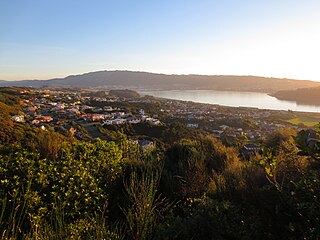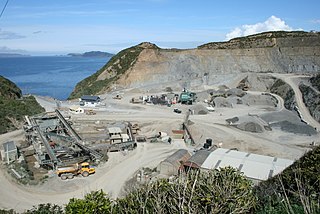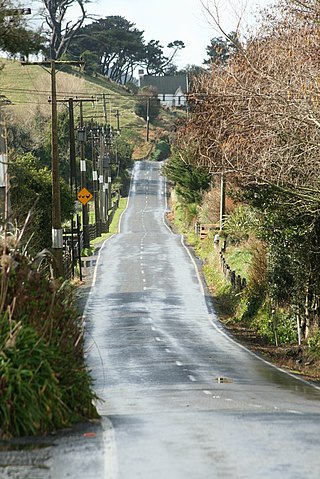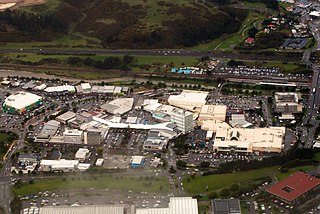
Porirua, a city in the Wellington Region of the North Island of New Zealand, is one of the four cities that constitute the Wellington metropolitan area. The name 'Porirua' is a corruption of 'Pari-rua', meaning "the tide sweeping up both reaches". It almost completely surrounds Porirua Harbour at the southern end of the Kāpiti Coast. As of 2023, Porirua has a population of 62,400 people, and is a diverse city with 26.5% of the population identifying as Pasifika and 23.0% of the population identifying as Māori.

Wellington City Council is a territorial authority in New Zealand, governing the city of Wellington, the country's capital city and third-largest city by population, behind Auckland and Christchurch. It consists of the central historic town and certain additional areas within the Wellington metropolitan area, extending as far north as Linden and covering rural areas such as Mākara and Ohariu. The city adjoins Porirua in the north and Hutt City in the north-east. It is one of nine territorial authorities in the Wellington Region.

The suburb of Plimmerton lies in the northwest part of the city of Porirua in New Zealand, adjacent to some of the city's more congenial beaches. State Highway 59 and the North Island Main Trunk railway line pass just east of the main shopping and residential area.

Tawa is the northernmost suburb within the Wellington city boundary, located roughly 15 km north of Wellington's CBD between Churton Park and Porirua in the North Island of New Zealand. It takes its name from the broadleaf tree, which was once prolific throughout the area, although its most famous tree is the Bucket Tree, a large macrocarpa with the topiary of an upside-down bucket. Tawa is also known for its large number of churches, representing a wide range of Christian denominations.

Pāuatahanui is a village in New Zealand's North Island. It is at the far eastern end of what was known as the Pāuatahanui Inlet, an arm of the Porirua Harbour, northeast of Wellington. In local government terms, Pāuatahanui is part of the Northern Ward of Porirua City.

Te Mārua is the easternmost urban suburb of Upper Hutt. For reasons of location and distance from the city, the area is often classified as rural. In December 2019, the approved official geographic name of the locality was gazetted as "Te Mārua".

Papakōwhai is a suburb of Porirua City. It lies approximately 22 kilometres (14 mi) north of Wellington in New Zealand.

The Akatarawa Valley is a valley in the Tararua Range of New Zealand's North Island. It provides a link from the upper reaches of the Hutt Valley to Waikanae on the Kāpiti Coast through rugged hill country. The valley is lowly populated and contains the localities of Reikorangi and Cloustonville. At the Hutt Valley end, the Akatarawa Valley is rugged and the Akatarawa River flows through it. The terrain is less difficult at the Kapiti end, where the Waikanae River flows through part of the valley on its route from its headwaters in the Tararuas to the Tasman Sea, and is met in the valley by tributaries such as the Ngatiawa River and the Reikorangi Stream.
Waitangirua is a suburb of Porirua City approximately 22km north of Wellington in New Zealand.

Wilton is a small suburb in Wellington. It is best known for Otari-Wilton's Bush, a large reserve that is situated in the suburb. Otari-Wilton's bush is the only public botanic garden in New Zealand dedicated solely to native plants. It features 14 km of walking tracks and a 'canopy walkway'. The canopy walkway is a raised walkway that provides a unique chance to view life in, and from, the top level of trees such as mature tawa, rewarewa and hinau.

Boulcott is a central suburb of Lower Hutt, in the Wellington Region of New Zealand. The suburb lies about a kilometre north-east of the Lower Hutt CBD.

Normandale is a semi-rural suburb of Lower Hutt City, New Zealand, on the western hills of the Hutt Valley. It consists of two main roads – Normandale Road and Miromiro Road – and the hills between, and is a five minute drive from the Lower Hutt city centre.

Grenada North is a small suburb in northern Wellington, New Zealand. It is 5 km south of Porirua's city centre, and 13 km north of Wellington's city centre. Its western boundary is formed by State Highway 1 and Takapu Road. The suburb itself was named after Grenada in the Caribbean, and most streets are named after Caribbean islands.

Horokiwi is an outer northern suburb of Wellington. The area is semi-rural and there are no schools; most children attend schools in nearby Lower Hutt, and Primary School zoning is for Korokoro. The only feature other than houses and farms is Horokiwi Quarry.

Linden is a subdivision of Tawa, the northernmost suburb of Wellington, New Zealand. Linden lies at the northern end of Tawa, just south of the city of Porirua.

Ohariu is a suburb of Wellington, New Zealand. It is a rural area, located 5 kilometres (3.1 mi) from Khandallah.
Moonshine Valley is a Rural Locality and thinly populated valley with a population of around 228 in the Wellington Region of New Zealand, centred on the Moonshine Hill Road which leaves State Highway 58 near Judgeford and goes over the Tararua Range to the Riverstone Terraces suburbs and then joins River Road, Upper Hutt. It straddles the council boundaries of Upper Hutt City and Kapiti Coast District.
Paparangi, one of the northern suburbs of Wellington in New Zealand, lies approximately 10 km north of the city centre, north-east of Johnsonville, north-west of Newlands and south of Grenada and Woodridge. The population was 2,841 at the time of the 2013 census, an increase of 96 from the 2006 census population.

Porirua Central is the central business district and central suburb of Porirua, in the Wellington region of New Zealand's North Island.

Paekākāriki Hill is a rural locality in Porirua in New Zealand's North Island. It is located inland, behind Paraparaumu and Raumati. Paekākāriki Hill Road runs approximately north to south from Paekākāriki to Pāuatahanui. Grays Road runs along the northern coast of Te Awarua-o-Porirua Harbour's Pauatahunui Arm, which forms the locality's southern boundary.


















